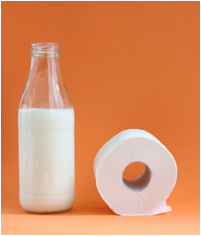
Lactose intolerance
by Cristine Bertochi
Lactose intolerance can be very uncomfortable, leaving us feeling bloated, gassy and uncomfortable. But being lactose intolerant doesn’t confine you to a life without milk, yogurt and cheese.
What does lactose intolerance mean?
Lactose is a naturally occurring sugar present in milk and milk-  derived dairy products. Within the digestive system, most of us have an enzyme called lactase that will digest the lactose into glucose and galactose, which our bodies can then metabolize. In some people, their bodies produce lower levels of this enzyme. Without lactase to break it down, lactose passes undigested into the GI tract. The bacteria that naturally reside there will ferment the lactose, which produces gas and the uncomfortable feelings associated with lactose intolerance. Sometimes after acute gastroenteritis, people can temporarily lose some of the lactase enzymes in their digestive tract and have a mild degree of lactose intolerance that may last for a week or two, but eventually does return to normal derived dairy products. Within the digestive system, most of us have an enzyme called lactase that will digest the lactose into glucose and galactose, which our bodies can then metabolize. In some people, their bodies produce lower levels of this enzyme. Without lactase to break it down, lactose passes undigested into the GI tract. The bacteria that naturally reside there will ferment the lactose, which produces gas and the uncomfortable feelings associated with lactose intolerance. Sometimes after acute gastroenteritis, people can temporarily lose some of the lactase enzymes in their digestive tract and have a mild degree of lactose intolerance that may last for a week or two, but eventually does return to normal |
Does this mean I can’t eat dairy?
|
So, what can I eat?
Lactose intolerance can be uncomfortable, but with a little patience and some smart choices, you can still enjoy your favorite foods and ensure that you’re getting all the nutrition milk has to offer. |
 |
Other related articles: Cow's Milk Pros and Cons
Calcium for Children and Teens
 |
Cristine Bertochi is a Registered Dietitian, living and working in Boston, Massachusetts. She received her Masters in nutrition from Boston University, and has experience providing medical nutrition therapy for a variety of disease states and populations of all ages, from pediatric weight management to geriatrics. She enjoys spreading information for good nutrition in creative ways |
 Just because you are lactose intolerant does not mean you have to steer clear of dairy. In fact, this is the last thing I would recommend. Dairy products are a great source of calcium, vitamin D and protein. Cutting dairy out of your diet completely could make it difficult to get adequate amounts of these nutrients.
Just because you are lactose intolerant does not mean you have to steer clear of dairy. In fact, this is the last thing I would recommend. Dairy products are a great source of calcium, vitamin D and protein. Cutting dairy out of your diet completely could make it difficult to get adequate amounts of these nutrients. People with lactose intolerance have several options. Yogurt is often tolerable, as long as it contains live active cultures. Those bacterial cultures will help to digest the lactose for you. Hard cheeses, such as cheddar and Swiss, are OK too, because the lactose-containing whey is removed in the cheese-making process. Soft cheeses, such as ricotta, contain some whey, but still may be tolerable in small amounts. In fact, many people with lactose intolerance can drink a full 8 oz of regular milk without any issues if they slowly train the bacteria in their guts to digest the lactose. You have to start small, with a tablespoon or two of milk, then slowly increase the portion over time based on how you tolerate it. If this does not work for you, there are several special products you can try. There are pills that contain enzymes to help digest lactose. You can also try a lactose free milk, such as Lactaid. There are also dairy substitutes, such as soy milk. Almond milk and coconut milk have become very trendy and popular, but I do not recommend these products as a substitute for dairy; they are nutritionally inadequate in terms of protein, and often have added sugar.
People with lactose intolerance have several options. Yogurt is often tolerable, as long as it contains live active cultures. Those bacterial cultures will help to digest the lactose for you. Hard cheeses, such as cheddar and Swiss, are OK too, because the lactose-containing whey is removed in the cheese-making process. Soft cheeses, such as ricotta, contain some whey, but still may be tolerable in small amounts. In fact, many people with lactose intolerance can drink a full 8 oz of regular milk without any issues if they slowly train the bacteria in their guts to digest the lactose. You have to start small, with a tablespoon or two of milk, then slowly increase the portion over time based on how you tolerate it. If this does not work for you, there are several special products you can try. There are pills that contain enzymes to help digest lactose. You can also try a lactose free milk, such as Lactaid. There are also dairy substitutes, such as soy milk. Almond milk and coconut milk have become very trendy and popular, but I do not recommend these products as a substitute for dairy; they are nutritionally inadequate in terms of protein, and often have added sugar.